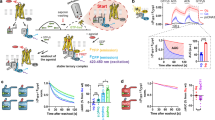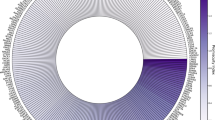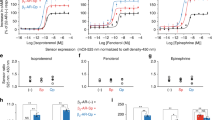Abstract
G protein-coupled receptors (GPCRs) selectively activate at least one of the four families of heterotrimeric G proteins, but the mechanism of coupling selectivity remains unclear. Structural studies emphasize structural complementarity of GPCRs and nucleotide-free G proteins, but selectivity is likely to be determined by transient intermediate-state complexes that exist before nucleotide release. Here we study coupling to nucleotide-decoupled G protein variants that can adopt conformations similar to receptor-bound G proteins without releasing nucleotide, and are therefore able to bypass intermediate-state complexes. We find that selectivity is degraded when nucleotide release is not required for GPCR–G protein complex formation, to the extent that most GPCRs interact with most nucleotide-decoupled G proteins. These findings demonstrate the absence of absolute structural incompatibility between noncognate receptor–G protein pairs, and are consistent with the hypothesis that transient intermediate states are partly responsible for coupling selectivity.

This is a preview of subscription content, access via your institution
Access options






Similar content being viewed by others
Data availability
All data generated or analyzed during this study are included in this published article and the accompanying Source data files. Plasmids encoding GPCR-Rluc8 and nucleotide-decoupled G protein constructs used in this study are freely available upon request. Structures 1GP2, 7CMV and 5KDO used to construct Fig. 1 are deposited in the Protein Data Bank (PDB) at https://www.rcsb.org/.
References
Pierce, K. L., Premont, R. T. & Lefkowitz, R. J. Seven-transmembrane receptors. Nat. Rev. Mol. Cell Biol. 3, 639–650 (2002).
Gilman, A. G. G proteins: transducers of receptor-generated signals. Annu. Rev. Biochem. 56, 615–649 (1987).
Wess, J. Molecular basis of receptor/G-protein-coupling selectivity. Pharmacol. Therapeutics 80, 231–264 (1998).
Conklin, B. R., Farfel, Z., Lustig, K. D., Julius, D. & Bourne, H. R. Substitution of three amino acids switches receptor specificity of Gqα to that of Giα. Nature 363, 274–276 (1993).
Qiao, A. et al. Structural basis of G(s) and G(i) recognition by the human glucagon receptor. Science 367, 1346–1352 (2020).
Mobbs, J. I. et al. Structures of the human cholecystokinin 1 (CCK1) receptor bound to Gs and Gq mimetic proteins provide insight into mechanisms of G protein selectivity. PLoS Biol. 19, e3001295–e3001295 (2021).
Rasmussen, S. G. F. et al. Crystal structure of the beta2 adrenergic receptor-Gs protein complex. Nature 477, 549–555 (2011).
Harris, J. A. et al. Selective G protein signaling driven by substance P-neurokinin receptor dynamics. Nat. Chem. Biol. 18, 109–115 (2022).
Mahoney, J. P. & Sunahara, R. K. Mechanistic insights into GPCR–G protein interactions. Curr. Opin. Struct. Biol. 41, 247–254 (2016).
Liu, X. et al. Structural insights into the process of GPCR-G protein complex formation. Cell 177, 1243–1251.e12 (2019).
Du, Y. et al. Assembly of a GPCR-G protein complex. Cell 177, 1232–1242.e11 (2019).
Kato, H. E. et al. Conformational transitions of a neurotensin receptor 1–Gi1 complex. Nature 572, 80–85 (2019).
Kaya, A. I. et al. A conserved hydrophobic core in Gα subi1/sub regulates G protein activation and release from activated receptor. J. Biol. Chem. 291, 19674–19686 (2016).
Dror, R. O. et al. SIGNAL TRANSDUCTION. Structural basis for nucleotide exchange in heterotrimeric G proteins. Science 348, 1361–1365 (2015).
Alexander, N. S. et al. Energetic analysis of the rhodopsin-G-protein complex links the α5 helix to GDP release. Nat. Struct. Mol. Biol. 21, 56–63 (2014).
Flock, T. et al. Universal allosteric mechanism for Gα activation by GPCRs. Nature 524, 173–179 (2015).
Grundmann, M. et al. Lack of beta-arrestin signaling in the absence of active G proteins. Nat. Commun. 9, 341–341 (2018).
Knight, K. M. et al. A universal allosteric mechanism for G protein activation. Mol. Cell 81, 1384–1396.e6 (2021).
Hollins, B., Kuravi, S., Digby, G. J. & Lambert, N. A. The C-terminus of GRK3 indicates rapid dissociation of G protein heterotrimers. Cell. Signal. 21, 1015–1021 (2009).
Kooistra, A. J. et al. GPCRdb in 2021: integrating GPCR sequence, structure and function. Nucleic Acids Res. 49, D335–D343 (2021).
Avet, C. et al. Effector membrane translocation biosensors reveal G protein and βarrestin coupling profiles of 100 therapeutically relevant GPCRs. eLife 11, e74101 (2022).
Rose, A. S. et al. Position of transmembrane Helix 6 determines receptor G protein coupling specificity. J. Am. Chem. Soc. 136, 11244–11247 (2014).
Kang, Y. et al. Cryo-EM structure of human rhodopsin bound to an inhibitory G protein. Nature 558, 553–558 (2018).
García-Nafría, J., Nehmé, R., Edwards, P. C. & Tate, C. G. Cryo-EM structure of the serotonin 5-HT1B receptor coupled to heterotrimeric Go. Nature 558, 620–623 (2018).
Koehl, A. et al. Structure of the µ-opioid receptor–Gi protein complex. Nature 558, 547–552 (2018).
Nehmé, R. et al. Mini-G proteins: novel tools for studying GPCRs in their active conformation. PLoS ONE 12, e0175642–e0175642 (2017).
Carpenter, B. & Tate, C. G. Engineering a minimal G protein to facilitate crystallisation of G protein-coupled receptors in their active conformation. Protein Eng. Des. Selection 29, 583–594 (2016).
Liang, Y. L. et al. Dominant negative G proteins enhance formation and purification of Agonist-GPCR-G Protein complexes for structure determination. ACS Pharm. Transl. Sci. 1, 12–20 (2018).
Yao, X. J. et al. The effect of ligand efficacy on the formation and stability of a GPCR-G protein complex. Proc. Natl Acad. Sci. USA 106, 9501–9506 (2009).
Gregorio, G. G. et al. Single-molecule analysis of ligand efficacy in β2AR-G-protein activation. Nature 547, 68–73 (2017).
Graham, G. J. D6 and the atypical chemokine receptor family: novel regulators of immune and inflammatory processes. Eur. J. Immunol. 39, 342–351 (2009).
Lu, S., Jang, W., Inoue, A. & Lambert, N. A. Constitutive G protein coupling profiles of understudied orphan GPCRs. PLoS ONE 16, e0247743–e0247743 (2021).
Vizurraga, A., Adhikari, R., Yeung, J., Yu, M. & Tall, G. G. Mechanisms of adhesion G protein-coupled receptor activation. J. Biol. Chem. 295, 14065–14083 (2020).
Flock, T. et al. Selectivity determinants of GPCR-G-protein binding. Nature 545, 317–322 (2017).
Okashah, N. et al. Variable G protein determinants of GPCR coupling selectivity. Proc. Natl Acad. Sci. USA 116, 12054–12059 (2019).
Brandt, D. R. & Ross, E. M. GTPase activity of the stimulatory GTP-binding regulatory protein of adenylate cyclase, Gs. Accumulation and turnover of enzyme-nucleotide intermediates. J. Biol. Chem. 260, 266–272 (1985).
Higashijima, T., Ferguson, K. M., Sternweis, P. C., Smigel, M. D. & Gilman, A. G. Effects of Mg2+ and the beta gamma-subunit complex on the interactions of guanine nucleotides with G proteins. J. Biol. Chem. 262, 762–766 (1987).
Stoveken, H. M., Hajduczok, A. G., Xu, L. & Tall, G. G. Adhesion G protein-coupled receptors are activated by exposure of a cryptic tethered agonist. Proc. Natl Acad. Sci. USA 112, 6194–6199 (2015).
Martin, A. L., Steurer, M. A. & Aronstam, R. S. Constitutive activity among orphan Class-A G protein coupled receptors. PLoS ONE 10, e0138463 (2015).
Takeo, Y., Kurabayashi, N., Nguyen, M. D. & Sanada, K. The G protein-coupled receptor GPR157 regulates neuronal differentiation of radial glial progenitors through the Gq-IP3 pathway. Sci. Rep. 6, 25180 (2016).
Kohno, M. et al. Identification of N-arachidonylglycine as the endogenous ligand for orphan G-protein-coupled receptor GPR18. Biochem. Biophys. Res. Commun. 347, 827–832 (2006).
Li, X. et al. Gpr125 modulates Dishevelled distribution and planar cell polarity signaling. Development 140, 3028–3039 (2013).
Eubelen, M. et al. A molecular mechanism for Wnt ligand-specific signaling. Science 361, eaat1178 (2018).
Kroeze, W. K. et al. PRESTO-Tango as an open-source resource for interrogation of the druggable human GPCRome. Nat. Struct. Mol. Biol. 22, 362–369 (2015).
Wan, Q. et al. Mini G protein probes for active G protein–coupled receptors (GPCRs) in live cells. J. Biol. Chem. 293, 7466–7473 (2018).
Lan, T.-H., Liu, Q., Li, C., Wu, G. & Lambert, N. A. Sensitive and high resolution localization and tracking of membrane proteins in live cells with BRET. Traffic 13, 1450–1456 (2012).
Acknowledgements
We thank A. Inoue for providing CRISPR-modified cells lacking Gα subunits and H. Hamm, S. Ikeda, K. Martemyanov, B. Roth and C. Zhang for providing plasmid DNA. This study was supported by National Institutes of Health grant nos. GM130142 and GM145284 (N.A.L.), GM136397 (G.W.) and a PhRMA Foundation Predoctoral Fellowship in Drug Discovery (W.J.).
Author information
Authors and Affiliations
Contributions
W.J. and S.L. performed all BRET experiments. S.L. constructed DNA plasmids encoding nucleotide-decoupled G proteins and receptors fused to luciferases. X.X. performed radioligand binding under the supervision of G.W. W.J. and N.A.L. conceived the project, designed experiments and drafted the manuscript. All authors reviewed and approved the final manuscript.
Corresponding authors
Ethics declarations
Competing interests
The authors declare no competing interests.
Peer review
Peer review information
Nature Chemical Biology thanks Alexander Hauser and the other, anonymous, reviewer(s) for their contribution to the peer review of this work.
Additional information
Publisher’s note Springer Nature remains neutral with regard to jurisdictional claims in published maps and institutional affiliations.
Extended data
Extended Data Fig. 1 G protein 4A interaction with the ligand-activated M4R is decoupled from nucleotide binding.
a, BRET between M4R-Rluc8 and wild-type (wt) Gi1 heterotrimers induced by the agonist acetylcholine (100 μM) in the absence of nucleotides was largely reversed by the addition of GTPγS or GDPβS (mean ± 95% C.I.; 12 replicates from three experiments each). b, The response for Gi1 4A was insensitive to GDPβS and partially sensitive to GTPγS (mean ±95% C.I.; 16 and 20 replicates from four and five experiments). c, βγ release-deficient Gi1 4A R208S nearly abolished GTPγS sensitivity of the receptor–G protein complex, suggesting that the nucleotide sensitivity of Gi1 4A reflects heterotrimer dissociation (mean ±95% C.I.; 12 replicates from three experiments each). d, BRET between M4R-Rluc8 and Gs 4A, Gq 4A and G13 4A is largely resistant to GDPβS (mean ±95% C.I.; 16 replicates from four experiments each); ΔBRET is the change in BRET above or below the baseline.
Extended Data Fig. 2 4A mutant Gα subunits sequester Gβγ dimers.
BRET between the βγ sensor memGRKct-Rluc8 and Venus-βγ dimers decreased when 4A mutant Gα subunits were expressed, indicating formation of heterotrimers and sequestration of free Gβγ dimers; Gα:Gβγ refers to the ratio of plasmid DNA used for transfection. In most cases Gβγ sequestration was partially reversed by the addition of GTPγS (100 μM). P values represent one-way ANOVA, Dunnett’s multiple comparisons; five independent experiments.
Extended Data Fig. 3 Nucleotide-decoupled G proteins bind to and promote the active state of GPCRs.
a, BRET between M4R and Gi1 4A is blocked by expression of the S1 subunit of pertussis toxin (PTX), and BRET between M4R Gi1 4A and Gs 4A is blocked by deletion of the last five amino acids of each Gα subunit (Δ5); mean ±s.d. of three (Gi1 4A and Gs 4A), four (Gi1 4A + PTX) and five (Gi1 4A Δ5 and Gs 4A Δ5) independent experiments. b, BRET between β2AR wild-type (wt) or N322K, which stabilizes the inactive state of the receptor, and Gs wt, Gs 4A, and midi Gs heterotrimers. The inactivating mutation abolished agonist-dependent association with Gs wt and converted spontaneous association with Gs 4A and midi Gs into agonist-dependent association; mean ±s.d. of four independent experiments. c, Agonist displacement of antagonist (CGP 12177) binding in intact cells expressing β2AR-Rluc8 and heterotrimers containing Gs wt, Gs 4A, or midi Gs. Expression of either nucleotide-decoupled G protein increases agonist binding affinity, although midi Gs appears to convert a higher fraction of the binding sites to a high-affinity (active) state. Curves were fit to a two-state competition binding model; mean ±s.d. of three independent experiments. All experiments were performed using intact cells, and a and b monitored BRET between Rluc8-tagged receptors and Venus-βγ.
Extended Data Fig. 4 Nucleotide-decoupled G proteins bind promiscuously to noncognate GPCRs.
Concentration–response curves of BRET between six different 4A G protein heterotrimers and 32 Rluc8-tagged GPCRs in response to agonists; mean ±s.e.m. of three independent experiments. Data points are fitted to a four-parameter variable-slope model. Receptors are arranged according to their putative primary G protein coupling families; when available, IUPHAR primary and secondary G protein coupling (primary, secondary) is shown in parentheses beside each receptor name. All experiments were performed using intact cells.
Extended Data Fig. 5 Noncognate receptor–G protein 4A complexes are less stable than cognate complexes.
a, Time course of complex dissociation in intact cells expressing M4R-Rluc8 and various 4A heterotrimers; receptors were preactivated with 100 μM acetylcholine (Ach) and complex dissociation was triggered by rapid addition of 10 μM atropine. Traces represent BRET normalized to baseline prior to addition of atropine and are the average of 12 replicates from three independent experiments. b, Time course of complex dissociation in intact cells in response to activation of unlabeled α2AR by rapid addition UK 14,304 (UK; 1 μM) in the continuous presence of 100 μM acetylcholine. Traces represent BRET normalized to baseline prior to addition of UK 14,303 and are the average of five to nine replicates from three independent experiments. In both cases cognate (Gi1 and Go 4A) complexes dissociate more slowly than noncognate complexes. All experiments were performed using intact cells.
Extended Data Fig. 6 Receptor interaction with nucleotide-decoupled 4A mutants is promiscuous compared to G protein activation.
Comparison of normalized maximum BRET (Emax) between receptors and 4A heterotrimers and G protein activation assessed using effector membrane translocation assays (EMTA) as reported by Avet and colleagues21, in both cases in the presence of saturating concentrations of agonists. This figure includes only the receptors and G proteins included in both studies.
Extended Data Fig. 7 Gi-coupled receptors accommodate the C terminus of nucleotide-decoupled Gs heterotrimers yet cannot activate wild-type Gs.
a, Agonist-dependent BRET between Rluc8-tagged Gi-coupled receptors α2AR or M4R and Gs 4A heterotrimers is nearly abolished when Gαs 4A is truncated by removing five amino acids from the C terminus (D5); mean ±s.d. of three and five experiments for Gs 4A and Gs 4A Δ5 respectively. b, Neither of these receptors is capable of stimulating adenylyl cyclase by activating wild-type Gs. Cyclic AMP (cAMP) was monitored using an EPAC-based BRET sensor; α2AR was stimulated with 1 μM UK 14,304 (UK) and M4R was stimulated with 10 μM oxotremorine M (OXO) agonist-induced activation; responses to 10 μM forskolin (FSK) are shown for comparison; ***P = 0.0005 and ****P < 0.0001, one-way ANOVA with Dunnett’s multiple comparisons; ns, not significant; three independent experiments.
Extended Data Fig. 8 Dominant negative (DN) G proteins have a milder nucleotide decoupling phenotype.
a, In permeabilized cells association of heterotrimers containing DN Gαs and Gαi1 with their cognate receptors (β2AR and α2AR) are both agonist- and nucleotide-dependent; mean ±s.d. of five independent experiments. b, In the absence of nucleotides DN Gs and Gi1 heterotrimers associated with noncognate receptors only modestly; mean ±s.d. of four independent experiments.
Extended Data Fig. 9 Screening of orphan GPCRs with G15 4A.
a, Agonist-dependent BRET between M3R-Rluc8 and G15 4A heterotrimers is insensitive to GDPβS (100 μM) at steady-state (left; mean ±s.d. of three independent experiments) or after rapid addition (right; mean ±95% C.I.; 12 replicates from three experiments). b, Heat map of basal BRET between the indicated oGPCRs and G protein 4A heterotrimers. Receptors shown in red bold italic font failed to reach the arbitrary net BRET threshold of 0.1 with any 4A heterotrimer; the promiscuous receptor MRGPRD is shown as a positive control. Each cell represents the mean of at least three independent experiments.
Extended Data Fig. 10 Pertussis toxin (PTX) sensitivity of basal BRET between oGPCRs and Gi1 4A.
Shown is basal BRET (mean ±s.d.) between oGPCR-Rluc8 receptors (also indicated on Fig. 6) and Gi1 4A in the absence and presence of coexpressed PTX for 3 (GPR150 and GPR151), 5 (GPR31) and 6 (GPR157) independent experiments.
Supplementary information
Source data
Source Data Fig. 2
Statistical source data.
Source Data Fig. 3
Statistical source data.
Source Data Fig. 4
Statistical source data.
Source Data Fig. 5
Statistical source data.
Source Data Fig. 6
Statistical source data.
Source Data Extended Data Fig. 1
Statistical source data.
Source Data Extended Data Fig. 2
Statistical source data.
Source Data Extended Data Fig. 3
Statistical source data.
Source Data Extended Data Fig. 4
Statistical source data.
Source Data Extended Data Fig. 5
Statistical source data.
Source Data Extended Data Fig. 6
Statistical source data.
Source Data Extended Data Fig. 7
Statistical source data.
Source Data Extended Data Fig. 8
Statistical source data.
Source Data Extended Data Fig. 9
Statistical source data.
Source Data Extended Data Fig. 10
Statistical source data.
Rights and permissions
Springer Nature or its licensor (e.g. a society or other partner) holds exclusive rights to this article under a publishing agreement with the author(s) or other rightsholder(s); author self-archiving of the accepted manuscript version of this article is solely governed by the terms of such publishing agreement and applicable law.
About this article
Cite this article
Jang, W., Lu, S., Xu, X. et al. The role of G protein conformation in receptor–G protein selectivity. Nat Chem Biol 19, 687–694 (2023). https://doi.org/10.1038/s41589-022-01231-z
Received:
Accepted:
Published:
Issue Date:
DOI: https://doi.org/10.1038/s41589-022-01231-z
This article is cited by
-
Time-resolved cryo-EM of G-protein activation by a GPCR
Nature (2024)
-
Binding kinetics drive G protein subtype selectivity at the β1-adrenergic receptor
Nature Communications (2024)
-
Stickier G-protein conformations
Nature Chemical Biology (2023)
-
Structural basis of omega-3 fatty acid receptor FFAR4 activation and G protein coupling selectivity
Cell Research (2023)
-
GPCRome-wide analysis of G-protein-coupling diversity using a computational biology approach
Nature Communications (2023)



